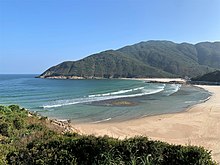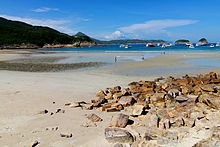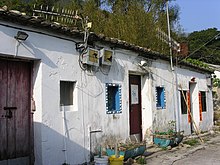Tai Long Sai Wan
Sai Wan (Chinese: 西灣; lit.: 'West Bay') is a beach in Sai Kung Peninsula, Hong Kong. To distinguish it from other bays and beaches of the same name, it is commonly known as Tai Long Sai Wan, as it is one of the four main beaches of Tai Long Wan. It came first in the Hong Kong Best 10 Scenic Sites Election in 2006.[1]




History
Sai Wan used to be a typhoon shelter for fishing boats but the High Island Reservoir project blocked the shortcut channel.[2]
Scenery
Sai Wan is situated in Sai Kung East Country Park at Stage 2 of the MacLehose Trail. It is next to Ham Tin Village, which has a restaurant that rents out camping equipment and surf boards apart from serving dishes.[3]
It is characterized by white sand and clear blue waters, which is attributable to its relative inaccessibility.[4] It is quiet and untainted, usually visited by junk-trippers and hikers only.[5]
It has been described as one of the best scenic spots in Sai Kung East or even Hong Kong. It came first in the Hong Kong Best 10 Scenic Sites Election in 2006.[1] Therefore, the bay is also known as "Hong Kong’s back garden".
Accidents
Tai Long Wan translates to "Big Wave Bay" in Cantonese, which indicates its strong currents. It is also not a gazetted public beach, which means it has no lifeguard and is not managed by the Leisure and Cultural Services Department. There is also no shark nets. It is not recommended for swimming.
Hong Kong Underwater Archaeological Association vice chairman and diving instructor Johny Lee said it was a wide beach with a narrow opening to the open sea, causing strong currents especially during September. He remarked that it was good for diving as the water was clear and one could observe the marine life of the area. However, he also noted that the strong current made it dangerous and people should be very careful if they decide to swim there.
A number of drownings have happened in the bay.[6]
Controversy
On 16 July 2010, it was reported that a large private development is under way in a site directly behind Sai Wan. It was revealed that businessman Simon Lo Lin-shing, chairman of Mongolia Energy Corporation and Vision Values Holdings, has acquired several plots of an abandoned village for a total of about HK$16 million to form the site that falls just outside the Hong Kong Country Parks & Special Areas and is not covered by any Outline Zoning Plans.[4]
The concerned strip of land, around 10,000 square metres in size, has been cleared of vegetation by diggers.[7] A warning sign is put up on the excavation site to warn against trespassing.
The nature of the private development is unclear. Villagers claimed that a private lodge will be built with artificial ponds, a tennis court and separate apartment.[7] Meanwhile, a spokeswoman for Vision Values Holdings said that there were no plans for any large-scale works, and that because the owner was very green himself, the land would be developed in a low-profile way. Lo also claimed he would be building an organic garden with pools for public use on the site.[8]
As of 23 July 2010, more than 68,000 people have joined the Facebook group that opposes the private development.[9] Green groups are planning a protest hike, tentatively set for 25 July 2010. A leading conservationist has said that the incident will give a bad impression to the UNESCO, which will be asked to grant World Heritage status to the Hong Kong National Geopark.[10]
Many were also infuriated with the government for not doing more to stop the destruction. After the reporting of the incident by the media on 16 July 2010, Secretary for the Environment Edward Yau Tang-wah was inquired about the incident on the next day but said he knew nothing about it.[11] Yau visited the site on 20 July 2010 and said the government had to strike a balance between respecting private land and protecting the environment.[12] Diggers have been mostly working on private land but a small section of the site is over government land. Yau warned the land owner that any redevelopment on agricultural land requires approval from the Lands Office, otherwise no construction work should proceed. The government has promised to meet with the landowner to work out a plan that will satisfy all parties concerned.[13]
Peter Li, campaign manager at the Conservancy Association, expressed disappointment with Yau's remarks, saying the government failed to make any concrete promises to address the issue. Designing Hong Kong convener Paul Zimmerman called on the government to restrict development even on private land near country parks: "They must now put up land control and planning control on those sites so they can no longer be destroyed." Other environmentalists urged that part or all of private land within country parks be repossessed to avoid further damage to the natural landscape.
Meanwhile, Secretary for Development Carrie Lam Cheng Yuet-ngor said the government will not repossess private land whenever there is a public outcry. Conservation may be achieved through many other ways, she said.
Sai Wan is also not the only scenic spot at risk: South China Morning Post reported that about 20 sites within or close to two country parks in Sai Kung are vulnerable to the same type of development.[14]
See also
- Historic churches of Sai Kung
References
- "Hong Kong Best 10 Scenic Sites Election Result". FOCP. Retrieved 22 July 2010.
- "Sai Wan Campsite". Agricultural, Fisheries and Conservation Department of the Hong Kong Government. Retrieved 22 July 2010.
- Christopher DeWolf (10 May 2010). "Summer dreaming: Hong Kong's best beaches". CNN GO. Retrieved 22 July 2010.
- Krista Mahr (16 July 2010). "In Hong Kong, One Paradise Lost". TIME.com. Retrieved 22 July 2010.
- Tiffany Lam (20 July 2010). "Protests over development near one of Hong Kong's best beaches". CNN GO. Retrieved 22 July 2010.
- Diana Lee (28 September 2009). "Student feared drowned at Sai Kung beach". The Standard. Archived from the original on 29 June 2011. Retrieved 22 July 2010.
- Cheung Chi-fai (16 July 2010). "It was a pristine picture at Sai Wan, but not any more". SCMP. Retrieved 26 February 2014.
- Samuel Chan (21 July 2010). "Beauty spot inaction upsets greens". The Standard. Archived from the original on 29 June 2011. Retrieved 22 July 2010.
- http://www.facebook.com/group.php?gid=119731658073048&v=wall
- Olga Wong (20 July 2010). "This will give a bad impression". SCMP. Retrieved 26 February 2014.
- Olga Wong; Maggie Tam (17 July 2010). "Sai Wan case? I don't know, says minister". SCMP. Retrieved 26 February 2014.
- Regina Leung (20 July 2010). "Yau visits controversial Sai Wan project". SCMP. Archived from the original on 21 March 2012. Retrieved 22 July 2010.
- Joy Li (21 July 2010). "Green groups to march against 'private lodge' in Sai Wan". China Daily. Retrieved 22 July 2010.
- Cheung Chi-fai; Olga Wong; Vivian Li (21 July 2010). "Sai Wan not the only site at risk". SCMP. Missing or empty
|url=(help)
External links
| Wikimedia Commons has media related to Sai Wan, Sai Kung. |